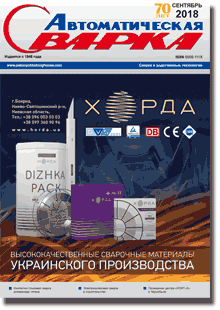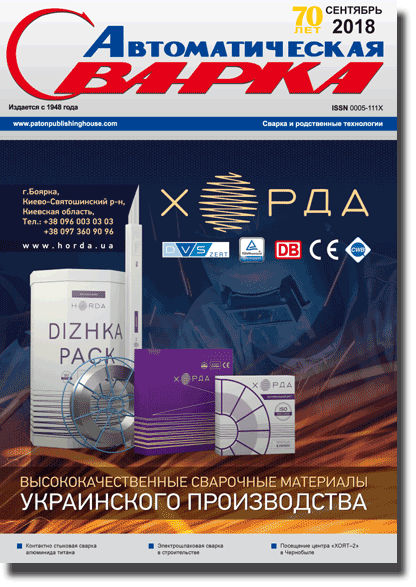| 2018 №09 (05) |
DOI of Article 10.15407/as2018.09.06 |
2018 №09 (07) |

Avtomaticheskaya Svarka (Automatic Welding), #9, 2018, pp. 35-40
Effect of alloying charge and external magnetic field on structure and properties of deposited metal
V.V. Peremitko, V. I. Sukhomlin, O. L. Kosinskaya, A. I. Panfilov
Dniprovsk State Technical University 2 Dneprovskaya Str., Kamenskoe, 51918. E-mail:welding@dstu.dp.ua
Effect of application of external magnetic field in arc surfacing over preliminary alloyed charge (carbon-containing fiber + SiO2) on hardness and metal properties as well as change of indicated indices within the limits of single beads was investigated. It is determined that carbon-containing fibers applied to the part surface being deposited provoke during surfacing local enrichment with liquid phase carbon, which in cooling decay for ferrite-carbide mixture, that leads to rise of metal hardness. Additional application of the external magnetic field in process of surfacing promotes intensive mixing of weld pool that results in production of more uniform structure and hardness. The analytical dependencies of hardness of deposited layers on amount of carbon-containing fibers, SiO2 + Fe and induction magnetic field were received. The results of the investigations can be used in development of technology for manufacture and restoration of parts operated under abrasive wear conditions. 9 Ref., 1 Tabl., 10 Fig.
Keywords: submerged arc surfacing, carbon-containing materials, modifying components, external magnetic field, deposited metal, hardness, microstructure
Received: 02.07.2018
Published: 20.09.2018
References 1. (2002) Restoration and improvement of wear resistance and service life of machine parts. Ed. by V.S. Popov. Zaporozhie, OJSC Motor Sich [in Russian].
2. Peremitko, V.V. (2014) Wear-resistant arc surfacing over the layer of alloying charge. The Paton Welding J., 8, 54–57. https://doi.org/10.15407/tpwj2014.08.09
3. Kuznetsov, V.D., Stepanov, D.V. (2015) Wear-resistant surfacing with feeding of nanopowders in welding pool. Ibid., 5-6, 47–51.
4. Frumin, I.I. (1961) Automatic electric arc surfacing. Kharkov, Metallurgizdat [in Russian].
5. Ryabtsev, I.A., Senchenkov, I.K. (2013) Theory and practice of surfacing works. Kiev, Ekotekhnologiya [in Russian].
6. Savulyak, V.I., Zabolotny, S.A., Shenfeld, V.J. (2010) Surfacing of high-carbon coatings using carbon fibers. Problemy Trybologii, 1, 66–70 [in Ukrainian].
7. Razmyshlyaev, A.D. (2000) Magnetic control of weld formation in arc welding. Mariupol, PSTU [in Russian].
8. Ryzhov, R.M., Kuznetsov, V.D. (2010) Magnetic control of welded joints quality. Kyiv, Ekotekhnologiya [in Ukrainian].
9. Bolshakov, V.I. (2015) Acicular ferrite. Visnyk Prydnipr. Derzh. Akademii Budivnytstva ta Arkhitektury, 9, 10–15 [in Russian].
The cost of subscription/purchase order journals or individual articles
| Journal/Currency | Annual Set | 1 issue printed |
1 issue |
one article |
| TPWJ/USD | 384 $ | 32 $ | 26 $ | 13 $ |
| TPWJ/EUR | 348 € | 29 € | 24 € | 12 € |
| TPWJ/UAH | 7200 UAH | 600 UAH | 600 UAH | 280 UAH |
| AS/UAH | 1800 UAH | 300 UAH | 300 UAH | 150 UAH |
| AS/USD | 192 $ | 32 $ | 26 $ | 13 $ |
| AS/EUR | 180 € | 30 € | 25 € | 12 € |
| SEM/UAH | 1200 UAH | 300 UAH | 300 UAH | 150 UAH |
| SEM/USD | 128 $ | 32 $ | 26 $ | 13 $ |
| SEM/EUR | 120 € | 30 € | 25 € | 12 € |
| TDNK/UAH | 1200 UAH | 300 UAH | 300 UAH | 150 UAH |
| TDNK/USD | 128 $ | 32 $ | 26 $ | 13 $ |
| TDNK/EUR | 120 € | 30 € | 25 € | 15 € |
AS = «Automatic Welding» - 6 issues per year;
TPWJ = «PATON WELDING JOURNAL» - 12 issues per year;
SEM = «Electrometallurgy Today» - 4 issues per year;
TDNK = «Technical Diagnostics and Non-Destructive Testing» - 4 issues per year.





